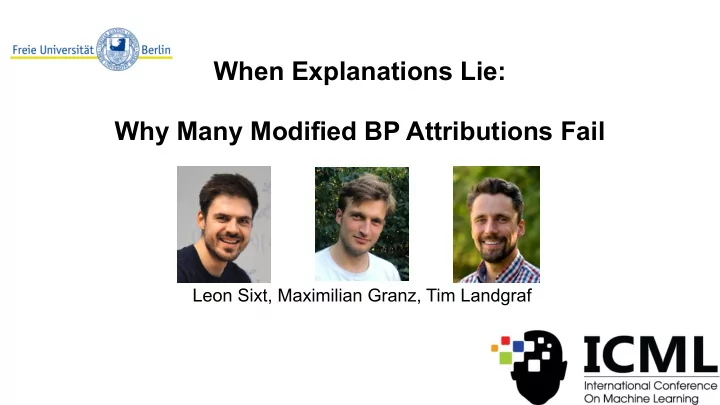

When Explanations Lie: Why Many Modified BP Attributions Fail Leon Sixt, Maximilian Granz, Tim Landgraf
Attribution Method: Explain class: “King Charles Network Spaniel” (156) Output Logits v cat backpropagate custom relevance score Saliency map indicates ‘important’ areas
Attribution Method: Explain class: “Persian cat” Network (283) Output Logits v cat backpropagate custom relevance score Does the saliency map indicate ‘important’ areas?
Sanity Check (Adebayo et al., 2018) Reset more layers ● Reset network parameter to initialization ● Saliency maps should change! ● Many modified BP methods fail: ○ PatternAttribution (Kindermans et al, 2017) ○ Deep Taylor Decomposition (Montavon et al., 2017) ○ LRP-αβ (Bach et al., 2015) ○ RectGrad (Kim et al., 2019) ○ Deconv (Zeiler & Fergus, 2014) ○ ExcitationBP (Zhang et al., 2018) ○ GuidedBP* (Springenberg et al., 2014) VGG-16 *already found by (Adebayo et al., 2018; Nie et al., 2018)
Short summary Main Finding: ● Many modified BP methods ignore deeper layers! ● Important to know if you can trust the explanations! In the talk: ● Intuition: Why later layers are ignored? ● Can we measure this behaviour?
z + -Rule Backpropagates a custom relevance score. Used by: ● Deep Taylor Decomposition ● LRP-α1β0 ● ExcitationBP (equivalent to LRP-α1β0) Next Steps: How does the z + -rule work for a layer? 1. 2. What happens for multiple layers?
z + -Rule: A single layer
z + -Rule: A single layer
z + -Rule: A single layer
z + -Rule: Matrix Weight strength Activation at layer l Normalize! The sum of relevance should remains equal
z + -Rule: Matrix Chain Per Layer, we obtain a matrix Explained Logit The matrix chain can be multiplied from left to right!
Geometric Intuition 1st Layer Possible positive linear combinations λ 1 a 1 + λ 2 a 2 λ 1 , λ 2 ≥ 0 Z + = ( a 1 a 2 ) = ( )
Geometric Intuition 2nd Layer Possible positive linear combinations
Geometric Intuition 3rd Layer Possible positive linear combinations
Geometric Intuition 4th Layer Possible positive linear combinations
Geometric Intuition 5th Layer Possible positive linear combinations
Geometric Intuition 6th Layer Possible positive linear combinations ● Output space shrink enormously! ● The saliency map is determined by early layers! (see our paper for a rigorous proof)
LRP-αβ ● What happens if we add a few negative values? ● Weight positive α and negative β weights differently: ● Restriction on α, β : ● Most common α=1, β=0 and α=2, β=1
More Attribution Methods See our paper for more methods: ● RectGrad, GuidedBP, Deconv ● LRP-z (non-converging, corresponds to grad x input ) ● PatternAttribution: also ignores the network prediction ● DeepLIFT: takes later layers into account
Cosine Similarity Convergence Backpropage Relevance Method to measure convergence 1. Sample two random vectors: 2. Backpropagate random relevance vectors cos similarity cos similarity cos similarity cos similarity 3. Per layer, measure how well they align.
CSC: VGG-16 Median over many images and random vectors
CSC: ResNet-50
CSC: Small CIFAR-10 Network
Summary Attribution Methods Insensitive to deeper layers Sensitive to deeper layers ● PatternAttribution ● DeepLIFT (Shrikumar et al., 2017) ● Deep Taylor Decomposition ● Gradient ● LRP-αβ ● LRP-z ● ExcitationBP ● Occlusion ● RectGrad ● TCAV (Kim et al., 2017) ● Deconv ● Integrated Gradients, SmoothGrad ● GuidedBP ● IBA (Schulz et al., 2020)
Outlook to the paper ● More modified BP methods: ○ RectGrad, GuidedBP, Deconv ○ LRP-z ○ PatternAttribution: also ignores the network prediction ○ DeepLIFT: does not converge ● We discuss ways to improve class sensitivity ○ LRP-Composite (Kohlbrenner et al., 2019) ○ Contrastive LRP (Gu et al., 2018) ○ Contrastive Excitation BP (Zhang et al., 2018) Do not resolve the convergence problem
Take away points ● Many modified BP methods ignore important parts of the network ● Check: If the parameter change, do the saliency maps change too? Thank you!
Recommend
More recommend